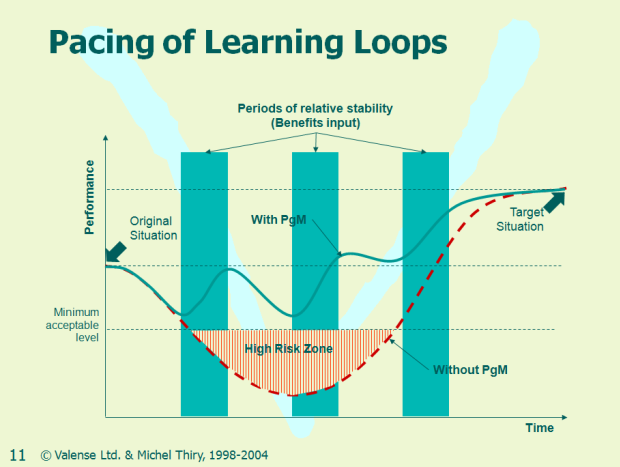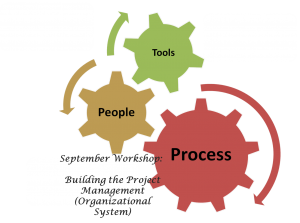Introduction
This article is a continuation on past articles and an extended discussion on the last post.
As a refresher, to build an effective and sustainable project management organizational system (PMOS), we presented our preferred approach, which is founded on three principles:
- Use a program management approach, in other words, treat the PMOS implementation initiative as a program rather than a project,
- Use an extended approach, meaning build the system over 1 to 3 years and not an intensive 3 to 6 months style,
- Follow the SUKAD Seven Elements of Project Management Maturity™ model (The 7Es™).
Why the program’s approach?
- Program sounds sexier than project:)
- Program is more grandiose
- Program is ‘strategic speak’
Seriously now!
There are three principal reasons:
- Extended approach with flexibility on time, accelerating or decelerating, and other factors make this more of a program rather than project with set deliverables and well defined time-frame.
- The organizational driver is for an initiative to enhance the organizational performance in managing the portfolio(s) – i.e. projects and programs; whether across the various functions or limited to a specific organizational unit. This situation makes a program approach as a better fit for such an initiative.
- A program approach allows us to set the program and strategic objectives, and then prioritize the various projects – on a case-by-case basis – to fit the organizational needs and expectations. Further, we can add or delete components on as needed basis.
It is worth noting that if the client chooses only a compressed implementation that could be well-defined, then we could have a project. On the other hand, if the client chooses the extended and staged approach, it would be best to treat this initiative, and the comprehensive engagement, as a program with multiple projects.
Possible program life cycle

In future articles we might discuss the details of the program but at this time we are keeping this confidential information.
Benefit of program management
We will try to explain using a graphic from a colleague and a PMI Fellow, Mr. Michel Thiry.
 What we understand from the diagram are:
What we understand from the diagram are:
- There are three horizontal dashed lines representing target situation, original situation, and minimum acceptable level.
- As an organization wanting to go from original to target situation, raise its performance level, it would need to implement new systems, policies, procedures, etc. Usually, that will have a negative impact in the early stage due to disruptions caused by the “change”, resistance to change, and the learning curve. This is shown in the line starting at the left axis and moving right and downward.
- If all the changes are implemented at once, sweeping organizational change, the large volume of new content, coupled with resistance to change, and learning-curve factor, the performance could continue to decline into the High Risk Zone, below the minimum acceptable level. This low performance will drag for a period of time before the performance starts to improve. Due to this situation and extended period in the high risk zone, there could be work disruptions, reduced motivation, losing trust in the system, and ultimately management might lose patience and abort the new system.
- Using a program management approach, with implementing smaller pieces of new work, there is time for assimilation and less resistance to change. Therefore, there is still a dip in performance but for a short time and will not likely go below the minimum acceptable level. Then there is an upswing since the team would have adopted the new process/system. This is what Mr. Thiry[1] calls a “period of relative stability”.
- With the recommended extended and staged approach, and with program management, we initially set up the high level system as an initial project. After a while, we come again to add a new project, new elements, and new learning. As the diagram shows, there will be a dip in performance for work related to the new elements, but possibly less severe than the earlier one.
- The process repeats over time until the organization reaches the target performance, and move on to continual improvement to sustain and move toward a center of excellence.
Basically, what we are saying is that through such an extended “program management” approach:
- The resistance to change is significantly reduced since the change is gradual and in small segments,
- The chance of success is higher, since the team has time to assimilate the learning, and
- The organization is capturing and realizing the benefits, continually and with each project, instead of waiting to the end of the program.
 Closing remarks
Closing remarks
What we are trying to present is how to build an effective and sustainable project management organizational system (PMOS), we presented our preferred approach, which is founded on three principles. Last time we discussed people-process-tools and extended staged approach. Today we discussed program management. In the next few articles, we will go back to the maturity model and discuss in more details some of the content for each of the seven elements!


This comment is By Paul Tiffany on LinkedIn:
Excellent!
This is similar to what our company has done for many of our clients who had dysfunctional Project “Management” Offices, almost always focused exclusively on information technology projects. We take a slightly different tack, which is to create the title Program Office, dropping the lame “Management” that no other department would ever include in its title. It is imperative to create an organization that drives business initiatives that may include, but not limited to, IT. Paramount is to establish accountability to the top business decision makers. They should drive the Program Office, not the other way around.
We have never had a problem convincing the appropriate top executive – CEO, COO or COB – of the wisdom of the approach. Usually the biggest concern comes from telling them that it will take two to three years before the new organization is running smoothly. Ouch! We have to repeat something they already know – the extent of change is extensive and everybody resists change, especially the experts, the Agents of Change. Other executives, their authority challenged by such a kick-ass organization, can be strong resistors and must be massaged, hopefully turning them into champions not saboteurs.
Thank you Paul for the response and valuable contribution – appreciate your time. I wish we could “have never had a problem convincing the appropriate top executive – CEO, COO or COB – of the wisdom of the approach.”
In our experience organizations want it NOW.